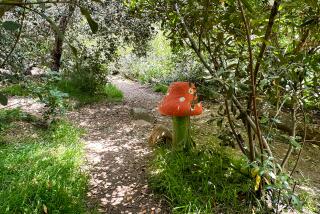‘It solves the problem of an ugly piece of ground.’
- Share via
It took awhile, but the dust has finally settled over the cactus and rock fracas in the Empty Saddle neighborhood of Rolling Hills Estates.
“It created quite a sensation, neighbor against neighbor, but it’s settled down now,” said Raymond T. Burns, president of the Empty Saddle Homeowners Assn.
The wrangle began two years ago when the association spent about $4,000 to create a Western scene--cactus, rocks and big Western fence posts--to beautify the entrance to the horse-oriented neighborhood at Rolling Hills and Empty Saddle roads. The city has a policy to reimburse homeowner associations up to $3,500 for such projects, but officials balked when several Empty Saddle residents submitted a petition objecting to the scene.
The association defended it, saying it replaced a collection of weeds and would not cost much to maintain.
Critics, however, said cactus and rocks were inappropriate for a neighborhood characterized by pepper trees, eucalyptus and ivy. They also feared vandalism, which indeed occurred soon after the work was completed. Burns said a noose was draped over a crossbeam and a dying cactus was spray-painted green.
The city put the reimbursement question on hold until the association could find out whether a majority in the community really wanted the Western scene.
That’s where things stood until February when, Burns said, the association--under new leadership--held a general meeting where residents said OK to the Western scene and agreed to spend $3,500 more to build two community identification signs with bases of Palos Verdes stone at the intersection.
That satisfied the City Council, which last week agreed to the $3,500 reimbursement. The entire project is to be finished in June.
Burns, who said he doesn’t really like the Western scene, called the association position a compromise.
“The first-born kid isn’t necessarily beautiful, but you don’t throw the baby out with the bathwater, you take care of it,” he said. “It solves the problem of an ugly piece of ground, and whether we like it or not, it’s there.”
More to Read
Sign up for Essential California
The most important California stories and recommendations in your inbox every morning.
You may occasionally receive promotional content from the Los Angeles Times.













